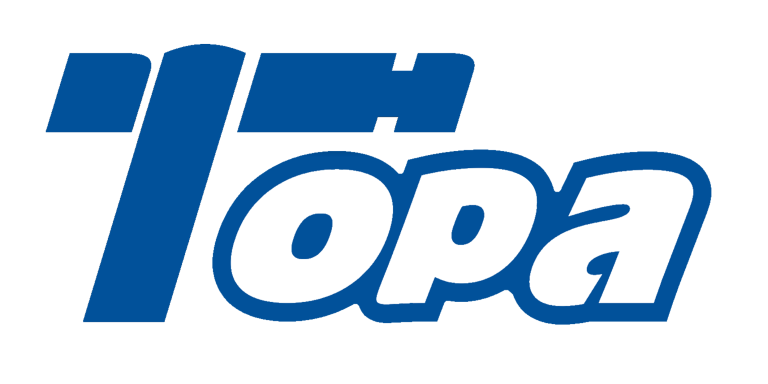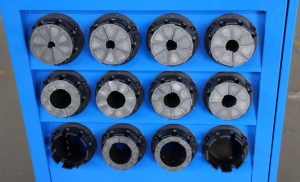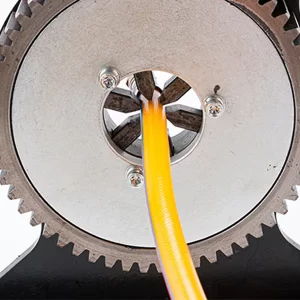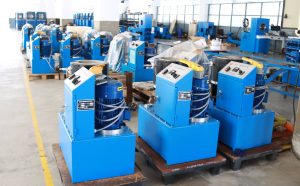Inspecting hydraulic hoses after crimping is crucial to guarantee safety, reliability, and performance. This article titled “What Key Inspection Steps Matter After Crimping a Hydraulic Hose?” delves into the critical inspection procedures that ensure each hose assembly meets required standards. But here’s the kicker: failing to perform proper inspections can lead to leaks, equipment failure, or even workplace hazards. Whether you’re managing a maintenance shop, manufacturing facility, or rental business, understanding these steps protects your investment and maintains operational excellence. From visual checks to pressure testing and documentation, we’ll cover everything you need for thorough, effective inspection.
1. What are the essential visual inspections after crimping a hydraulic hose?
Visual inspections form the first line of defense against defective hose assemblies. Operators must carefully examine the crimped area for uniformity, absence of cracks, dents, or other deformities. What’s the real story? Uniform crimps without irregularities indicate proper compression and secure fitting. Inspectors also check for visible damage to the hose body, such as abrasions, cuts, or swelling that could compromise hose integrity. For instance, a construction company reduced failure rates by implementing standardized visual checks before dispatch. They trained technicians to identify subtle imperfections early, preventing costly downtime and recalls. Lighting and magnification tools further enhance defect detection. Overall, visual inspection prevents obvious failures before advanced testing begins.
| Inspection Focus | Common Defects | Detection Tools |
|---|---|---|
| Crimp uniformity | Uneven crimps, gaps | Visual and magnifiers |
| Hose body condition | Cuts, abrasions, swelling | Bright lighting |
| Fitting position | Misalignment | Visual and measurement tools |
2. How should the crimp diameter be measured and verified?
Measuring crimp diameter is a precise process to confirm that the crimp falls within manufacturer specifications. Using calibrated calipers or dedicated crimp diameter gauges, inspectors measure around the crimped sleeve to ensure it matches set tolerances. Ready for the good part? Consistency in crimp diameter directly correlates with hose strength and leak prevention. A hydraulic service center improved product reliability by standardizing crimp diameter checks and documented results. They found that even small deviations could lead to failures under pressure. Accurate measurement avoids both over-crimping, which can damage fittings, and under-crimping, which can cause leaks. Repeatability across batches ensures quality assurance.
| Measurement Tool | Usage | Accuracy Level |
|---|---|---|
| Digital Calipers | Measure crimp diameter | ±0.01 mm |
| Crimp Diameter Gauge | Quick pass/fail checks | Manufacturer-specified |
| Tape Measure | Hose length verification | ±1 mm |
3. What pressure testing procedures validate hose integrity?
Pressure testing confirms that the hose assembly can withstand operational pressures without leaks or failures. Hydrostatic pressure testing involves filling the hose with water or fluid and pressurizing it above working levels for a specified time. Pneumatic testing uses air pressure to detect leaks. This is where it gets interesting: appropriate pressure settings and durations are critical. A mining operation documented a 0% failure rate after adopting hydrostatic testing at 1.5 times maximum working pressure for five minutes. Pneumatic tests are faster but require stringent safety precautions due to air compressibility. These tests simulate real-world stresses and verify assembly robustness before use.
| Test Type | Method | Typical Pressure Settings |
|---|---|---|
| Hydrostatic | Fluid pressurization | 1.25 to 1.5 times working pressure |
| Pneumatic | Air pressurization | 1.1 times working pressure |
| Leak Detection | Soap bubble or ultrasonic | During or after pressurization |
4. How does a leak test complement the crimp inspection process?
Leak tests target micro-leaks that visual or pressure tests might miss. Common methods include soap bubble application on crimp areas to observe bubbles, or ultrasonic detectors that identify escaping air or fluid sounds. But here’s the kicker: leak tests improve safety by preventing catastrophic failures. A hydraulic rental company integrated ultrasonic leak detection and reduced customer complaints related to slow leaks by 40%. Repeating leak tests at multiple stages ensures integrity throughout the hose’s lifespan. Leak detection is often combined with pressure testing for comprehensive evaluation.
| Leak Test Method | Description | Sensitivity |
|---|---|---|
| Soap Bubble | Apply soap solution | Detects visible air leaks |
| Ultrasonic Detection | Uses sound waves | Detects tiny leaks invisible to the eye |
5. What role does dimensional inspection play in post-crimp quality control?
Dimensional inspection verifies hose length, fitting alignment, and overall assembly conformity. Precise hose lengths ensure proper fit in machinery, while alignment prevents stress points. Tools such as micrometers and length gauges help maintain these specifications. Ready for the good part? A hydraulic manufacturer found dimensional compliance critical for avoiding premature hose wear and failures. Operators used laser measuring tools to improve accuracy and reduce human error. Maintaining dimensional integrity ensures safety, performance, and customer satisfaction.
| Dimensional Check | Measurement Tools | Importance |
|---|---|---|
| Hose Length | Tape measure, laser tools | Correct system fit |
| Fitting Alignment | Visual guides, jigs | Prevents bending stress |
| Crimp Location | Measurement from hose ends | Ensures proper hose routing |
6. How should operators document inspection results?
Accurate documentation is essential for traceability, quality assurance, and regulatory compliance. Operators record inspection data in logs or digital systems, detailing measurements, test results, and observations. What’s the real story? A company that implemented digital inspection logs reduced errors and improved audits. These records help identify recurring issues and inform maintenance schedules. Software solutions allow quick data retrieval and trend analysis. Clear documentation also facilitates communication between operators, supervisors, and customers, ensuring transparency and accountability.
| Documentation Method | Description | Benefit |
|---|---|---|
| Paper Logs | Manual recording | Simple and accessible |
| Digital Systems | Electronic data capture | Easy retrieval and analysis |
| Photo Documentation | Visual proof | Enhances verification |
7. What common defects should inspectors look for after crimping?
Inspectors should be vigilant for defects like over-crimping, which deforms fittings, and under-crimping, which causes loose seals. Crimp cracks, material deformation, and improperly seated fittings are also red flags. This is where it gets interesting: identifying defects early prevents costly failures. A workshop using a detailed defect checklist reduced return rates by 30%. Defects can lead to leaks, hose bursts, or premature wear, jeopardizing equipment and personnel safety. Training inspectors on defect recognition is vital for maintaining quality standards.
| Defect Type | Cause | Impact |
|---|---|---|
| Over-crimping | Excessive pressure | Fitting damage, leaks |
| Under-crimping | Insufficient compression | Loose fittings, leaks |
| Crimp Cracks | Material fatigue or damage | Hose failure |
8. How do environmental factors influence inspection accuracy?
Environmental factors like poor lighting, dust, or temperature extremes can hinder inspection accuracy. Insufficient lighting makes defect detection difficult, and dust can mask surface issues. But here’s the kicker: proper workspace conditions, including clean environments and magnification tools, improve inspection reliability. A factory that upgraded its inspection lighting and installed clean air systems saw defect detection rates improve by 20%. Temperature fluctuations can affect measurement tools, so stable conditions are preferred for precise inspection.
| Environmental Factor | Impact | Mitigation |
|---|---|---|
| Poor Lighting | Missed defects | Bright, adjustable lights |
| Dust and Debris | Conceals surface issues | Air filtration and cleaning |
| Temperature Variance | Measurement inaccuracies | Climate control |
9. What are the best practices for training inspectors?
Structured training ensures inspectors are skilled in detecting defects and using measurement tools accurately. Best practices include hands-on sessions, certification programs, and continuous education on new standards. Ready for the good part? A company with a formal training program reduced inspection errors by 35%. Training also covers safety protocols and proper documentation. Ongoing refreshers keep inspectors updated on evolving technologies and techniques.
| Training Component | Delivery Method | Outcome |
|---|---|---|
| Hands-on Workshops | Practical exercises | Skill development |
| Certification | Formal testing | Quality assurance |
| Continuous Learning | Online courses, seminars | Keeps knowledge current |
10. How do automated inspection systems enhance quality control?
Automated systems use cameras, lasers, and sensors to perform precise, repeatable inspections. They detect defects and measure dimensions faster than manual methods. This is where it gets interesting: automation reduces human error and increases throughput. A large manufacturing plant implemented automated visual inspection, cutting defect escapes by 50%. Data from these systems integrates with quality management software, enabling real-time process adjustments.
| Automated Tool | Function | Advantage |
|---|---|---|
| Vision Systems | Defect detection | High-speed, consistent checks |
| Laser Gauges | Dimensional measurement | Precision and accuracy |
| Data Integration | Quality data management | Real-time monitoring |
11. What safety protocols should be followed during inspection?
Safety during inspection involves handling pressurized hoses cautiously, wearing PPE, and following lockout/tagout procedures. Inspectors must be aware of pinch points and fluid injection hazards. But here’s the kicker: adherence to safety standards reduces accidents and liability. Companies enforcing strict safety protocols during inspection reported zero incidents over several years. Training includes recognizing hazards and emergency procedures, ensuring inspector well-being.
| Safety Measure | Purpose | Benefit |
|---|---|---|
| PPE Usage | Protects from injury | Reduces accident risk |
| Lockout/Tagout | Prevents unexpected energizing | Ensures safe maintenance |
| Hazard Awareness | Recognizes fluid and mechanical risks | Minimizes exposure |
12. How can inspection findings guide preventive maintenance?
Inspection data highlights wear trends and early faults, enabling proactive maintenance. Detecting minor crimp issues or seal degradation helps schedule timely repairs. Ready for the good part? A fleet management company reduced breakdowns by 40% using inspection-driven maintenance plans. Continuous feedback loops improve machine performance and hose life. Tracking inspection outcomes informs part replacements and operator training needs.
| Maintenance Focus | Triggered By Inspection Data | Benefits |
|---|---|---|
| Seal Replacement | Detected leaks or wear | Prevents failure |
| Die Adjustment | Inconsistent crimps | Maintains quality |
| Training Updates | Recurring operator errors | Improves assembly |
13. How do industry standards influence inspection criteria?
Inspection procedures align with ISO, SAE, and other industry standards specifying acceptable tolerances and testing methods. Compliance ensures safety and customer confidence. This is where it gets interesting: manufacturers require documented inspections to meet warranty and certification demands. Standards evolve, so inspections must adapt to maintain relevance. Adherence protects against liability and maintains market competitiveness.
| Standard | Focus | Impact |
|---|---|---|
| ISO 9001 | Quality management | Consistent production |
| SAE J517 | Hose and fitting specs | Safety and compatibility |
| API and OSHA | Safety and environmental | Regulatory compliance |
14. What tools are indispensable for effective post-crimp inspections?
Essential tools include micrometers, digital calipers, crimp diameter gauges, pressure testers, and leak detection devices. But here’s the kicker: quality and calibration of tools affect inspection accuracy. Companies investing in precision instruments report fewer assembly defects. Portable inspection kits improve flexibility, enabling field inspections without sacrificing rigor.
| Tool | Function | Key Feature |
|---|---|---|
| Micrometer | Measures hose and fitting dimensions | High precision |
| Pressure Tester | Validates hose integrity | Adjustable pressure ranges |
| Leak Detector | Identifies micro-leaks | Sensitivity and portability |
15. How can companies develop a robust inspection checklist?
Creating clear, comprehensive checklists standardizes inspection steps and criteria. Checklists should specify pass/fail thresholds for visual, dimensional, and pressure tests. Ready for the good part? Regular review and updates based on feedback ensure checklists stay relevant. Training inspectors on checklist use promotes consistency. Digital checklist platforms can facilitate data capture and audit readiness.
| Checklist Component | Purpose | Implementation |
|---|---|---|
| Visual Criteria | Defect identification | Illustrated guidelines |
| Measurement Ranges | Acceptable tolerances | Manufacturer specs |
| Test Procedures | Pressure and leak tests | Step-by-step instructions |
FAQ Section
Q1: What is a hydraulic hose crimp inspection?
It is the process of checking crimp quality to ensure hose integrity and safety after assembly.
Q2: How does pressure testing work in hose inspections?
Pressure testing applies specified hydraulic or pneumatic pressure to check for leaks or failures.
Q3: What common defects are found after crimping?
Defects include uneven crimps, cracks, loose fittings, and damaged seals.
Q4: Why is documentation important in inspections?
Documentation ensures traceability, quality control, and compliance with standards.
Q5: How do automated systems improve inspection quality?
Automated systems provide precise measurements, reduce human error, and enhance consistency.




